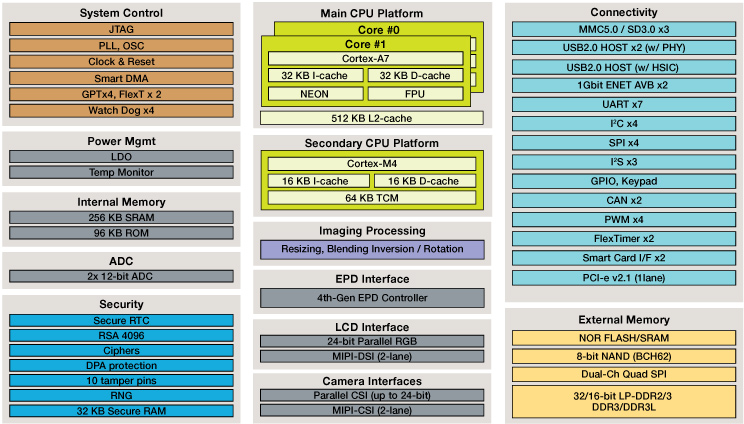Freescale announced plans for i.MX 7 and i.MX 8 processors in 2013, but it’s only in the last few months there have been some patchsets submitted to the ARM Linux Kernel mailing list, and so far all documentation was only available to companies and developers under NDA. Now the company has officially launched i.MX 7 series, and although all documents are not available yet, Freescale has released a factsheet providing an overview about the processors. Freescale i.MX 7 series processors targets applications such as wearables, e-readers, secure point-of-sale equipment, smart home controls, industrial automation products and other IoT solutions.

Two processors are currently available: the single core i.MX 7Solo processor, and the dual core i.MX 7Dual processor. Both basically share the same specifications, but beside the extra Cortex A7 core, i.MX 7Dual also adds on extra USB host port, a PCIe interface, an extra Gigabit Ethernet port, and a 4th generation EPD controller.
Freescale i.MX 7 specifications:
- Main CPU
- i.MX 7Solo – ARM Cortex A7 @ 800 MHz with 512KB L2 cache, 256KB SRAM, 96KB ROM
- i.MX 7Dual – 2x ARM Cortex A7 @ 1.0 / 1.2 GHz with 512KB L2 cache, 256KB SRAM, 96KB ROM
- Secondary CPU – ARM Cortex M4 @ 266 MHz
- Memory I/F
- 16-/32-bit DDR3/DDR3L and LPDDR2/3 @ 533 MHz
- MMC 5.0; 3x SD 3.0
- NOR Flash/SRAM I/F
- 8-bit NAND I/F
- Dual channel Quad SPI
- Connectivity – 1 or 2 Gigabit Ethernet (AVB)
- Display
- 24-bit parallel RGB
- MIPI DSI (2 lanes)
- EPD controller (7Dual only)
- Camera
- Parallel CSI (up to 24-bit)
- MIPI CSI (2 lanes)
- Other Interfaces
- 1 or 2 USB 2.0 host (w/ PHY), 1x USB 2.0 host interface (w/ HSIC)
- 7x UART, 4x I2C, 4x SPI
- 3x I2S
- 2x CAN
- 4x PWM
- 2x FlexTimer
- 2x SmartCard I/F
- 2x 12-bit ADC
- PCI-e slot (1x lane, 7Dual only)
- Security with tamper resist – Secure RTC, RSA 4096, Ciphers, 10-pin tamper, etc…
- Manufacturing – 28nm ultra low leakage process technology
Freescale claims their i.MX 7 Series processors consume about one third of their i.MX 6 Series based on Cortex A9 cores, with a core efficiency of 15.7 DMIPS/mW, and a new Low Power State Retention mode (LPSR) of 250 μW. The processors will also be coupled with the new PF3000 PMIC to achieve higher efficiency.

A SABRE board with i.MX 7Dual will also be available, and integrate a PF3000 PMIC, Wi-Fi 802.11 ac/a/b/g/n, Bluetooth 4.1 and an SD card preinstalled with a Linux based operating system, and Android is also available from Freescale. I could not find details or pricing (usually around $500) for the development board.
i.MX 7Solo and i.MX 7Dual processors are sampling now, with mass production scheduled for November 2015. More information should soon become available on Freescale i.MX 7 Series product page.
Thanks to Nanik for the tip.

Jean-Luc started CNX Software in 2010 as a part-time endeavor, before quitting his job as a software engineering manager, and starting to write daily news, and reviews full time later in 2011.
Support CNX Software! Donate via cryptocurrencies, become a Patron on Patreon, or purchase goods on Amazon or Aliexpress




